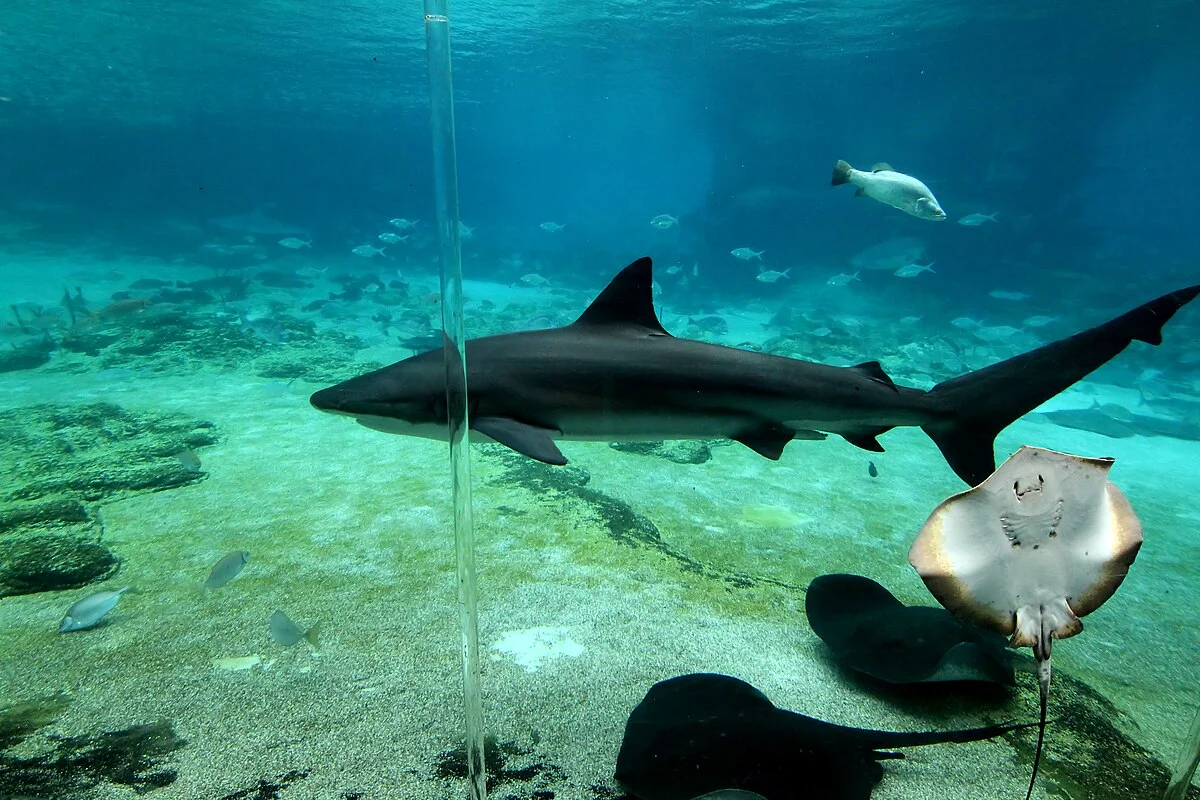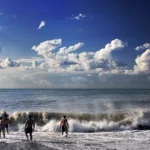Panama City Beach, Florida woke up to a wild scene on the morning of July 31. About thirty feet from shore, a hammerhead shark and a hefty stingray thrashed in waist-deep water while families watched in disbelief.
Videos of the fight raced through TikTok, Instagram, and Facebook within hours, bringing a sudden spotlight to Florida’s Gulf Coast wildlife. Marine scientists say the encounter was dramatic but normal.
Here is the full story of what happened, why hammerheads hunt stingrays in shallow surf, and how beachgoers can stay safe without missing the beauty of the Gulf.
The moment caught on camera
Vacationers Annie Kremer and Connor Pelt were setting up chairs behind Watercrest Condominiums when a large fin cut the surface. Kremer grabbed her phone; within seconds the water exploded.
A broad-winged stingray tried to flee, lifting one pectoral fin high, while the shark circled and lunged. Kremer’s clip shows the shark biting the ray’s trailing edge, then both animals disappearing in a cloud of sand.
Her friends yell “Move back, move back,” before the pair swim off in different directions. No swimmers were hurt, but dozens left the water until lifeguards confirmed the shark had moved on.
Why hammerheads hunt near the beach
Great hammerhead sharks patrol both the Atlantic and Gulf coasts of Florida. Adults often exceed twelve feet and females can reach nineteen. Their wide head acts like an underwater metal detector, packed with sensors that pick up the faint electrical fields of buried prey.
Stingrays hide under sand in water as shallow as three feet, so hammerheads regularly cruise close to swimmers.
Biologists with the Florida Fish and Wildlife Conservation Commission (FWC) note that hammerheads strongly prefer rays and skates to bony fish. The prey choice explains why tourists sometimes see a three-hundred-pound predator feet from the shoreline.
Stingrays are risky prey
Catching a ray is not easy. Southern stingrays, the likely species in this clash, can span five feet and carry a venom-tipped spine near the tail base.
Reports from similar hunts show hammerheads often take repeated bites to weaken the ray while dodging the barb. The Panama City video hints at that caution; the shark grips the ray’s pectoral corner, not the centerline where the spine sits.
Marine ecologists at the University of Florida explain that hammerheads usually flip rays on their back to stun them before biting the head. The fight may take minutes, during which time both animals can drift into very shallow water.
How common are shark sightings in Panama City
Bay County lifeguards list hammerheads, blacktips, and bulls as regular summer visitors. Most appear at dawn when bait schools move along the bar.
Still, shark bites on people are rare. The International Shark Attack File recorded fifty-one unprovoked bites worldwide in 2024, five in the Gulf, none fatal. Hammerheads are even less likely to bite humans than bulls or tigers, since their primary prey is rays.
The social media ripple effect
Within six hours Kremer’s TikTok had more than two million views. National outlets such as People and Fox Weather ran the footage, sparking debates about surf safety and wildlife ethics.
Comment sections filled with praise for Florida’s natural drama, along with calls for shark nets. FWC officials responded on their own social feeds, reminding residents that the Gulf is a living habitat, not a pool. They urged viewers to respect marine life and avoid viral-video “chases.”
Expert breakdown of the footage
Marine scientist Dr. Carla Gomez watched the clip for Fox Weather. She identified the shark as a juvenile female hammerhead around ten to twelve feet. The stingray appeared to be a southern ray based on fin curvature and color.
Gomez noted the ray’s defensive posture: wings curled, tail whipping. She pointed out that the shark never fully subdues the ray on camera, which supports witness comments that the animals separated. She called the event “a textbook hammerhead hunt that many Floridians never get to see.”
Safety tips for swimmers and waders
- Enter the surf after the first sandbar moves into full sun. Sharks feed most actively at dawn and dusk.
- Shuffle your feet in knee-deep water. Rays often bury themselves; the shuffle warns them off and prevents stings.
- Stay in groups. Sharks are curious but avoid clusters of loud humans.
- Skip shiny jewelry. Reflections can mimic fish scales.
- Obey flag warnings. Red or purple flags often indicate large marine life sightings.
Local lifeguards also recommend rinsing any fish scraps from hands before swimming and staying within sight of a tower whenever possible.
What to do if you spot a shark
If you see a fin inside the first bar, exit slowly and calmly. Splashing or rushing can draw curiosity. Alert the nearest lifeguard or dial the posted beach patrol number.
Officials only close beaches when sharks linger or show aggressive feeding near swimmers, which is uncommon.
Stingray hazards and first aid
Stingray injuries occur more often than shark bites on Gulf beaches. If stung, rinse the wound, soak it in water as hot as tolerated for thirty to ninety minutes, and seek medical care.
The venom is protein-based and breaks down with heat. Local clinics keep supplies of hot packs and pain relief for such cases.
Environmental context: hot summer, busy wildlife
Gulf sea surface temperatures in July reached eighty-seven degrees, two above average. Warmer water draws baitfish into the shallows, attracting both rays and their predators.
Coastal conservation groups note that healthy predator numbers signal a robust ecosystem. The hammerhead–stingray encounter therefore shows that the local food chain is functioning.
Previous hammerhead sightings in the region
Panama City Beach has hosted similar spectacles. In 2022 anglers filmed a fifteen-foot hammerhead chasing a school of cownose rays near the pier.
Last summer surf fishers released an eight-foot hammerhead caught on cut bait at night. None of those scenes ended in human injuries.
How local businesses reacted
Water-sport rental firms paused paddleboard bookings for two hours on July 31 to avoid sending clients into an active hunting zone.
By afternoon, normal operations resumed. Restaurant patios overlooking the Gulf reported an uptick in lunchtime diners hoping to spot wildlife, turning the viral moment into a tourism boost rather than a scare.
Balancing thrill and respect
Long-time Panama City charter captain Mike Torres sees the fascination. He has led shark-watch trips for a decade and believes education is the best solution.
“People fear what they do not understand,” he says. He shows guests dorsal-photo catalogs and explains each species’ role. After the hammerhead video, bookings for his educational cruises climbed.
Research value of citizen video
The footage gives biologists rare documentation of natural predation in nearshore surf. University teams can study angle of attack, prey response, and water clarity.
Citizen-shot clips also help refine local shark-distribution maps when paired with tide and temperature logs.
Conclusion: coexistence on the coast
The shark and stingray fight off Panama City Beach reminds visitors that the Gulf is a living arena. Sightings thrill and educate when viewed with respect.
Following basic safety guidelines keeps risks low while preserving unforgettable moments. Locals hope the viral attention encourages travelers to view Florida’s beaches as more than just sun and sand but as habitats where powerful marine stories unfold every day.













